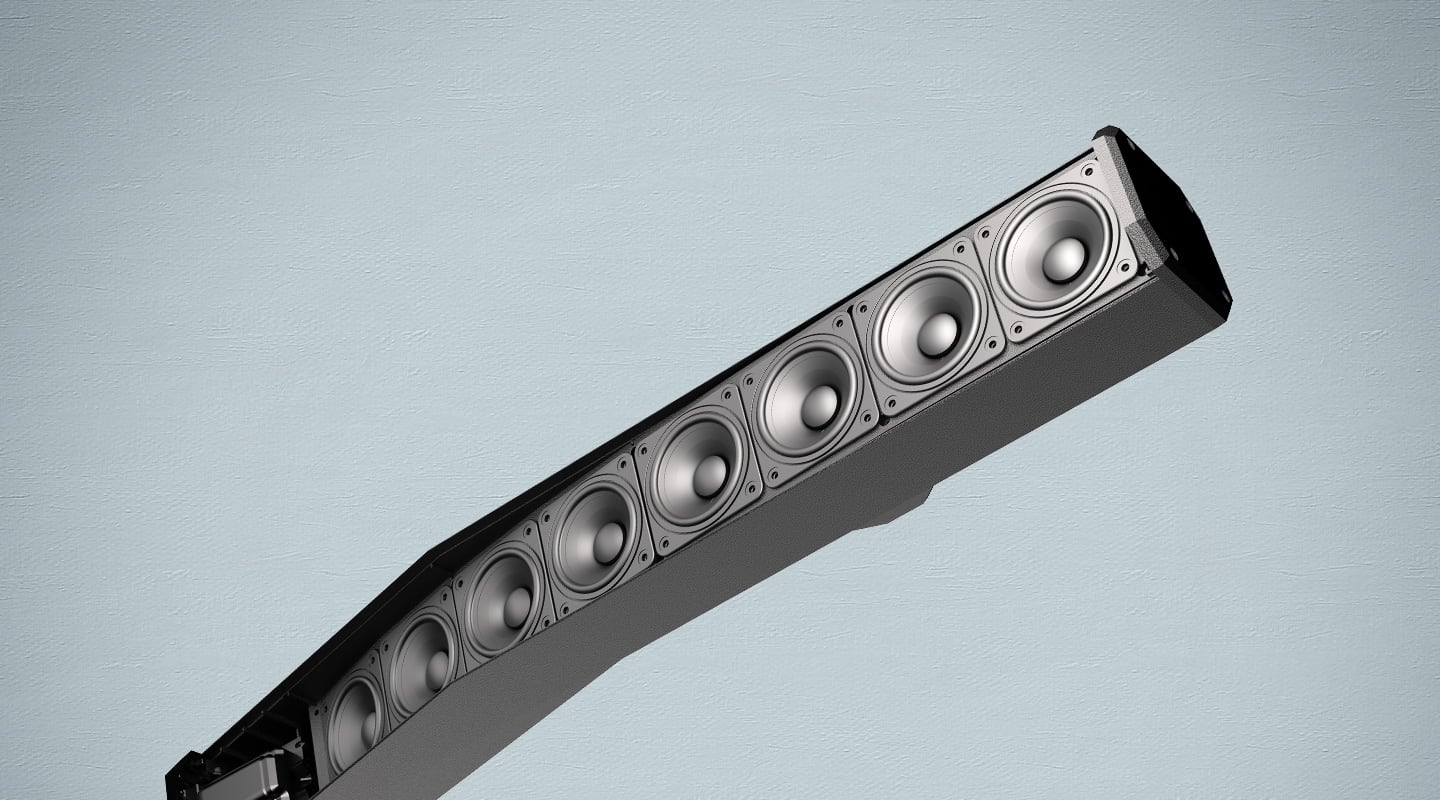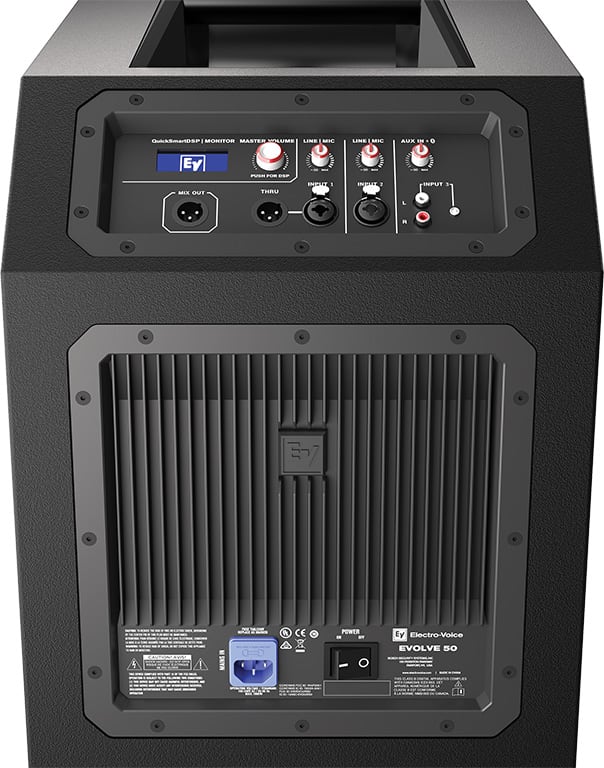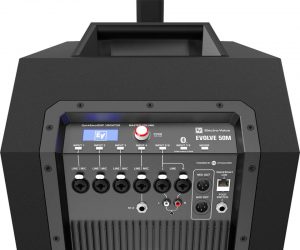
EV Evolve 50
For when a stick PA is too ‘slim’ for your tastes.

Six seconds. That’s how long the EV rep reckoned it would take to get the Evolve 50 set up. Challenge accepted. By the time we got the column bits unzipped and stacked, then found a spot to plug in the power cord, it was more like 60 seconds. Six, or 60, who cares — that’s quick, very quick! Quicker than any column speaker we’ve set up in the past. No cables, no shims; nothing but a magnetic pole to slip in between your speaker column and sub.
A minute later, we were all staring at the Evolve 50, and while it took the form of a stick PA, it was immediately obvious there were some ideological differences to Bose’s original ‘one-PA-for-every performer’ paradigm. For starters, it has a built-in J-curve, the sort of curved bottom system techs will induce into a concert line array to cover the floor while still projecting into the stands. Great when the rig is flown four storeys into the air, but when the whole thing stands barely over two metres tall, that bottom lip is just pointing straight at your feet.
EV says its for when you have the PA up on a stage, with a shorter pole coming to compensate. It still doesn’t account for the 90% of the time the thing sits on the floor. Thankfully it didn’t adversely affect the PA’s definition, and the curve does form a nice bow shape, with a large carry handle rather like a string connecting two ends of a stave.
EV is serious about the Evolve 50 breaking away from the mono nature of stick PAs and turning out in stereo too. You can easily hook up two of these systems to flank either side of a stage. It’s as simple as setting the Mix Out option in the DSP to ‘R’ — for right channel — running an XLR cable across to input one of the other speaker, and it will automatically split the stereo RCA/minijack/Bluetooth input across the two speakers. The other two input channels remain in mono. If you want to mix more inputs in stereo, you’ll have to bring your own mixer.
SKINNY BUT LOUD
Thankfully, EV hasn’t just gone for the directionality and stereo utility of a ‘proper’ PA, it sounds like one too. Evolve 50 is one of the more potent stick PAs we’ve tested. It’ll blow your socks off if you let it. It’s loud, registering 127dB SPL at one metre. It’s also not laid back like the Bose L1’s natural-sounding delivery. It has punch, enough to handle rock ’n’ roll duties. It has a peak around 10kHz, and most of the DSP modes (other than the scooped Music setting) have a presence bump at 2kHz which makes it a little bitier than other stick PAs. I generally had it on the flatter Live setting, with the treble turned down one or two dB.
Of all the stick PAs we’ve tested, the Bose shined for its natural reproduction, the JBL Eon One was an all-round great sounding system that proved a dark horse for its price, and the HK Elements system had a clarity and three-dimensionality to the vocals that was unparalleled. The EV Evolve 50 is more aggressive than any of those. It’s powerful and suited to anyone looking into the stick PA format who doesn’t want to stray too far away from the sound and ‘balls’ of a typical top box and sub combination.
NEED TO KNOW
EV Evolve 50
Column Loudspeaker
STEREO STICKS
The Evolve 50 can happily live in both worlds: while it will work as a bonafide stereo rock PA, it still holds the single stick pose well.
When it comes down to it, a portable column speaker needs to do a few things well: it has to be easy to set up, have a wide horizontal spread, high feedback rejection, and have enough inputs on the back to cater for most gigs.
Evolve 50 goes up quickly, covers 120 degrees in the horizontal plane, and you can stand in front of it with a mic without any issues. So let’s look at those inputs.
The onboard mixer has three channels; two mic/line inputs on combo jacks, and a stereo input that can be fed via a minijack, RCA, or a Bluetooth stream.
The mono inputs have an interesting design. It didn’t appear to matter whether you plugged a mic or line source into either jack or XLR inputs, the volume control still exhibited the same range. There was plenty of level for any source and plugging a line input into the XLR didn’t send it off. No mic/line switches; it just worked. It seems a relatively foolproof design that adapts to the user. Nice. On the downside, there’s no dedicated instrument/DI input.
Initially, I didn’t think that would be a problem for me, as I carry my own LR Baggs Para DI with my acoustic. However, when I plugged it in and turned phantom power on, it didn’t work. On further investigation I found out the phantom power only ran +15V, not the +48V I needed to run that particular device. It was probably unfortunate the first thing I plugged in was too power hungry; reviewer’s luck, I guess. EV says the reduced phantom power is designed for the lower power requirements of condenser microphones. For the DI, it was just a matter of breaking out a 9V battery.
Rounding out the input section, the screen defaults to show input meters for all three channels. It’s a nice touch to see whether you’re peaking.

TEETH TO IT
EV has gone heavy into Bluetooth on Evolve 50. You can use Bluetooth to both control the device via the EV Quicksmart mobile app — available for iOS and Android devices — as well as stream music directly to channel three of the onboard mixer. To stream you just have to scroll to the Bluetooth menu and click on ‘Streaming’ to start the pairing process. No codes required and I had music playing off my iPhone 6 in a jiffy. In the same Bluetooth menu on the speaker you also have the option to turn on Control App, which opens up a dialogue with the EV Quicksmart app. I had both Bluetooth streams running simultaneously without any problems.
Quicksmart is a simple app that gives you immediate access to master mute and volume. It also gives you control over the three-band EQ, with a range of -12 to +6dB in 1dB steps. There is a selectable mid frequency that can range from 200Hz to 12kHz, but you can only access that control via the touch ’n’ turn knob on the mixer unit. It would have been nice if this was included in the app, too.
There are also four overall modes; Club, Music, Live and Speech. They range from bass-heavy to bass cut, with Live being the flattest of the bunch. They’re all well designed presets that don’t go too hard either way. The EQ and presets are available via the DSP menu on the mixer, but it’s orders of magnitude easier to use the app than a push button scroll wheel.
Other onboard functions include fine control of sub level between -80dB to +10dB, or the option to mute it. You can also send a pre-fader signal to a different speaker via the Thru output. If you’re using the pre-or post fader output, you can also set it up with the delay setting that reads simultaneously in meters and feet. It can go up to 100m in increments of 10cm. The rest of the menu includes controls for LED on or off, display brightness and contrast settings, as well as the ability to store and recall up to five system settings.

STICK EVOLUTION
It’s obvious that EV intends for the Evolve 50 to be more than just a stick shadowing a performer. It breaks from the ideologies of its predecessors, but it’s better for it. Rather than being a me-too product, EV has taken a step towards fulfilling the true potential of stick PAs; an easy-to-use PA, for any occasion. With the ability to simply set it up as a stereo PA, and its powerful rock ’n’ roll capable voicing, you won’t have to worry about it not playing its role.



























Do you think two could power a 3 piece rock cover band?
Hi Andy. It depends on the size of the venue but two of these would handle your average pub gig for sure.
Can it handle up to 500 people like Bose’s L1 Model 2 can?